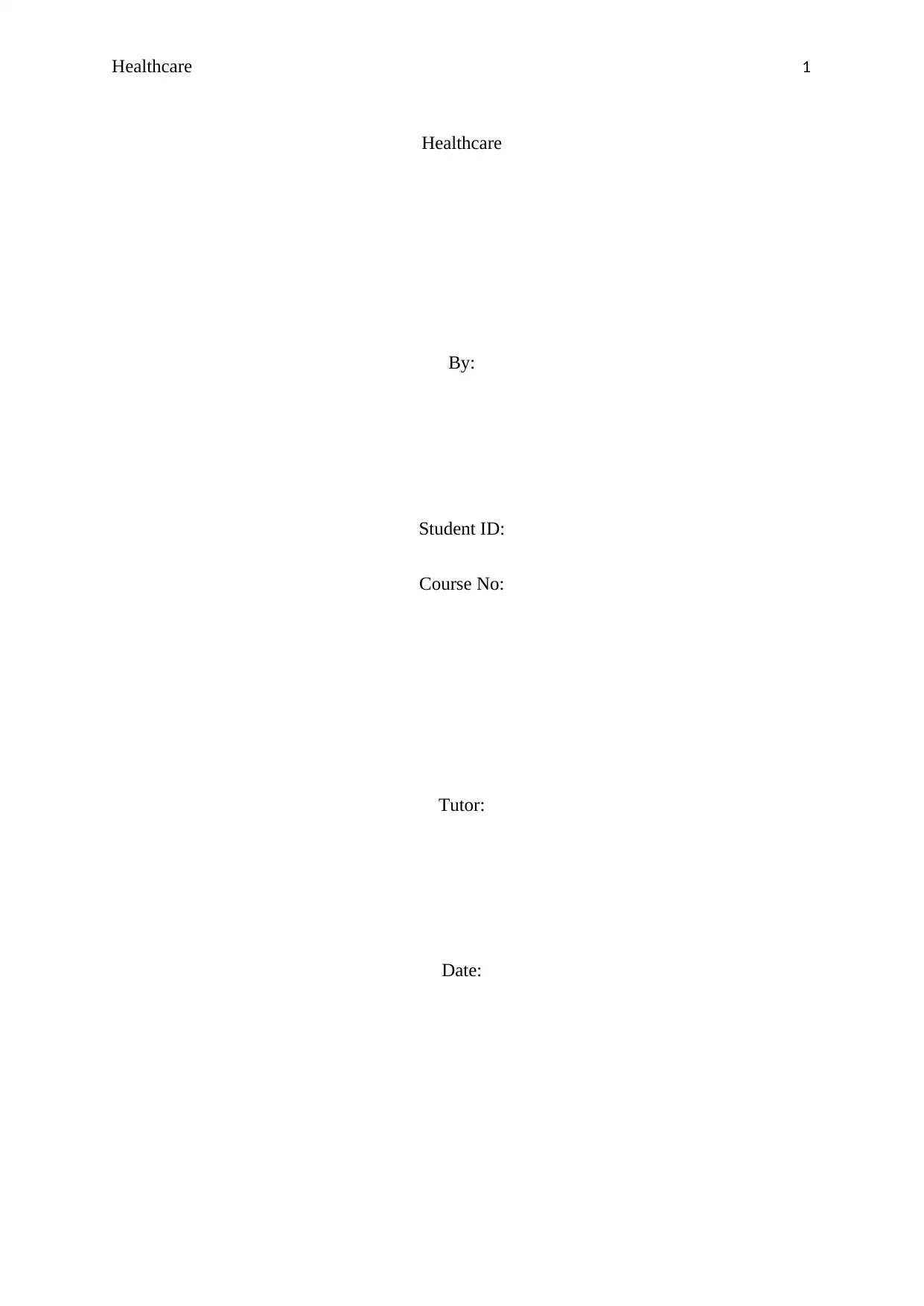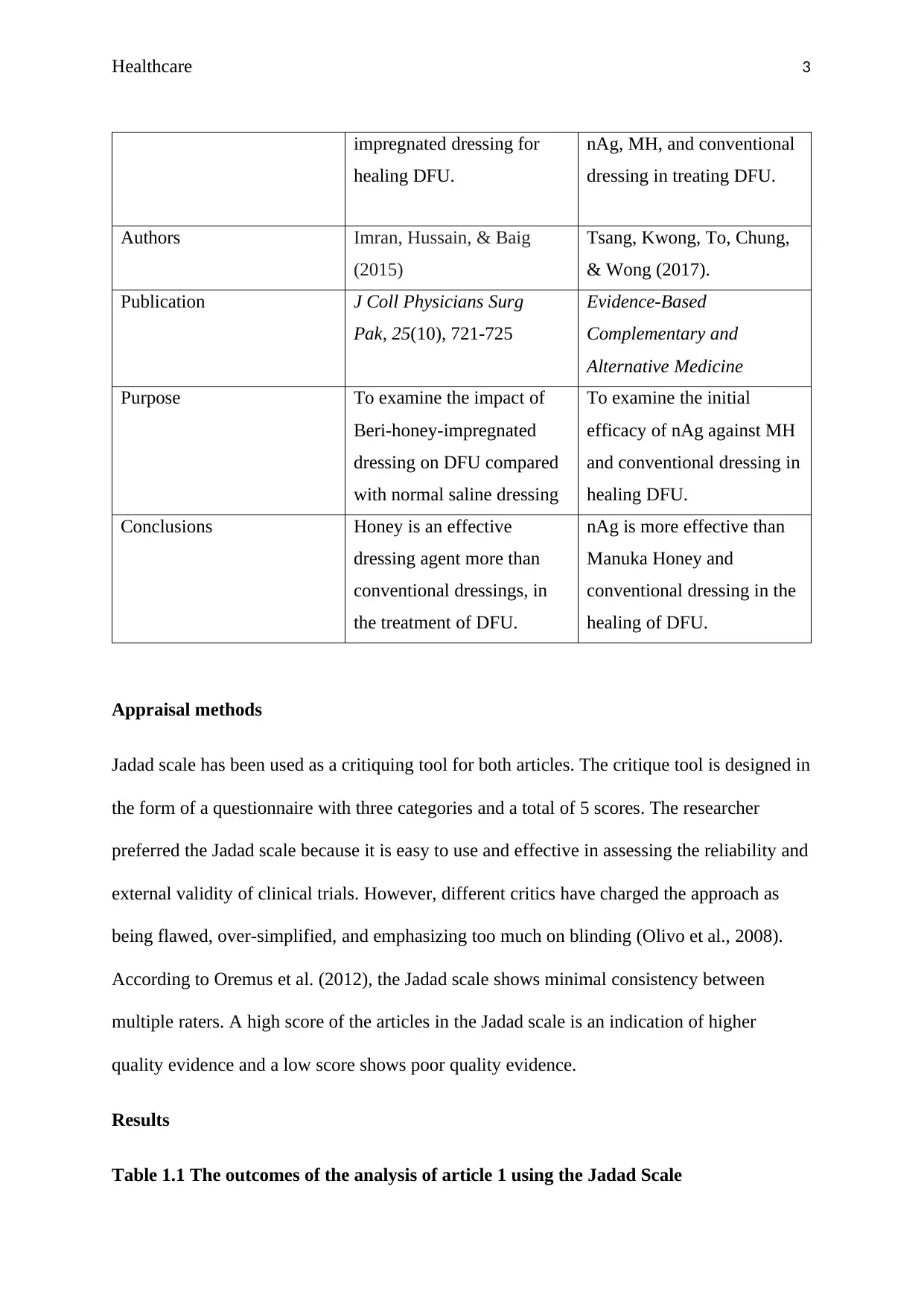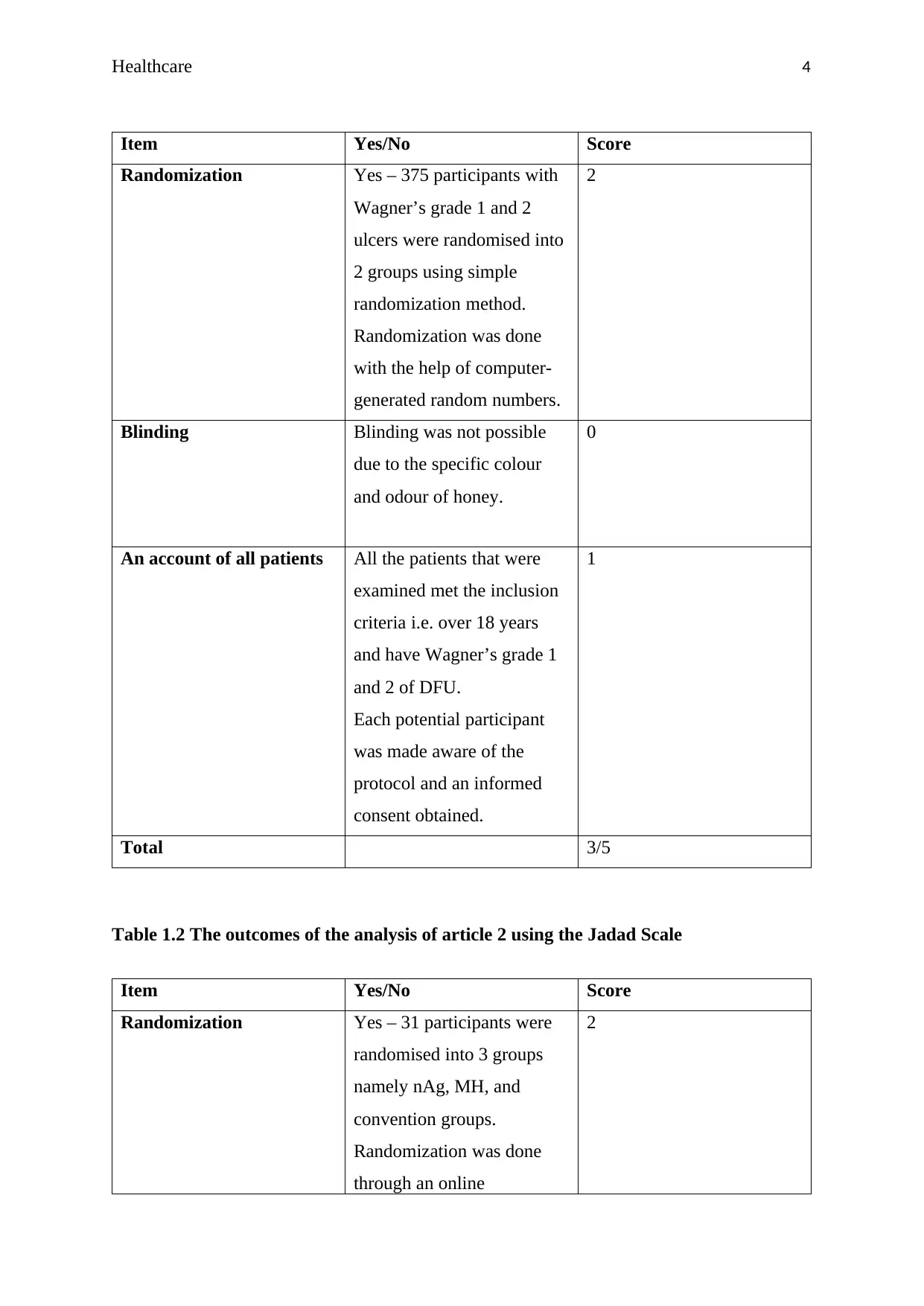Review: Honey Dressing Efficacy for Diabetic Foot Ulcer Healing
VerifiedAdded on 2023/04/19
|8
|1569
|178
Report
AI Summary
This report critically appraises two randomized controlled trials (RCTs) to determine the effectiveness of honey dressing in treating diabetic foot ulcers (DFU) compared to conventional methods. Using the Jadad scale, the studies by Imran et al. (2015) and Tsang et al. (2017) were evaluated. The findings suggest that honey dressing, particularly nanocrystalline silver (nAg), demonstrates superior efficacy in promoting DFU healing. While both studies scored well on the Jadad scale, the report highlights the scale's limitations, particularly its emphasis on blinding. The conclusion emphasizes the potential benefits of incorporating honey dressing into clinical practice for improved patient outcomes and cost-effective healthcare, advocating for its consideration by clinicians in DFU management. Desklib provides access to this and other solved healthcare assignments for students.

Healthcare 1
Healthcare
By:
Student ID:
Course No:
Tutor:
Date:
Healthcare
By:
Student ID:
Course No:
Tutor:
Date:
Paraphrase This Document
Need a fresh take? Get an instant paraphrase of this document with our AI Paraphraser

Healthcare 2
Picot Framework
Problem Diabetes Foot Ulcers
Intervention Honey dressing
Comparison Conventional dressing; nAg
Outcome Honey dressing more effective
Time 3 years
Clinical question: Is honey dressing more effective in the treatment of diabetic foot ulcer
than other conventional dressing?
Introduction
Diabetes mellitus (DM) is one of the global health challenges that account for 382 million
people or 8.3% of the world population (Ogurtsova et al., 2017). These statistics are ever
reported to be on the rise, making diabetic foot ulcer (DFU) an international health problem.
DFUs are amongst the leading causes of disability in people with DM, and it causes over half
of all painless amputations globally (Burns & Jan, 2012). The overall prevalence of
individuals diagnosed with new incidences of foot ulcer after five years is at 76.4% leading to
47.1% chances of re-amputation (Chu et al., 2016). Several studies have found out that
wound dressing is significant in the management of DFU. Honey dressing is the most
common alternative and has been supported by multiple literatures.
This report aims at critically appraising two randomised controlled trials (RCT) on the
usefulness of honey dressing in managing DFU.
The Research Studies
Title Article 1: A RCT of honey- Article 2: A pilot RCT of
Picot Framework
Problem Diabetes Foot Ulcers
Intervention Honey dressing
Comparison Conventional dressing; nAg
Outcome Honey dressing more effective
Time 3 years
Clinical question: Is honey dressing more effective in the treatment of diabetic foot ulcer
than other conventional dressing?
Introduction
Diabetes mellitus (DM) is one of the global health challenges that account for 382 million
people or 8.3% of the world population (Ogurtsova et al., 2017). These statistics are ever
reported to be on the rise, making diabetic foot ulcer (DFU) an international health problem.
DFUs are amongst the leading causes of disability in people with DM, and it causes over half
of all painless amputations globally (Burns & Jan, 2012). The overall prevalence of
individuals diagnosed with new incidences of foot ulcer after five years is at 76.4% leading to
47.1% chances of re-amputation (Chu et al., 2016). Several studies have found out that
wound dressing is significant in the management of DFU. Honey dressing is the most
common alternative and has been supported by multiple literatures.
This report aims at critically appraising two randomised controlled trials (RCT) on the
usefulness of honey dressing in managing DFU.
The Research Studies
Title Article 1: A RCT of honey- Article 2: A pilot RCT of

Healthcare 3
impregnated dressing for
healing DFU.
nAg, MH, and conventional
dressing in treating DFU.
Authors Imran, Hussain, & Baig
(2015)
Tsang, Kwong, To, Chung,
& Wong (2017).
Publication J Coll Physicians Surg
Pak, 25(10), 721-725
Evidence-Based
Complementary and
Alternative Medicine
Purpose To examine the impact of
Beri-honey-impregnated
dressing on DFU compared
with normal saline dressing
To examine the initial
efficacy of nAg against MH
and conventional dressing in
healing DFU.
Conclusions Honey is an effective
dressing agent more than
conventional dressings, in
the treatment of DFU.
nAg is more effective than
Manuka Honey and
conventional dressing in the
healing of DFU.
Appraisal methods
Jadad scale has been used as a critiquing tool for both articles. The critique tool is designed in
the form of a questionnaire with three categories and a total of 5 scores. The researcher
preferred the Jadad scale because it is easy to use and effective in assessing the reliability and
external validity of clinical trials. However, different critics have charged the approach as
being flawed, over-simplified, and emphasizing too much on blinding (Olivo et al., 2008).
According to Oremus et al. (2012), the Jadad scale shows minimal consistency between
multiple raters. A high score of the articles in the Jadad scale is an indication of higher
quality evidence and a low score shows poor quality evidence.
Results
Table 1.1 The outcomes of the analysis of article 1 using the Jadad Scale
impregnated dressing for
healing DFU.
nAg, MH, and conventional
dressing in treating DFU.
Authors Imran, Hussain, & Baig
(2015)
Tsang, Kwong, To, Chung,
& Wong (2017).
Publication J Coll Physicians Surg
Pak, 25(10), 721-725
Evidence-Based
Complementary and
Alternative Medicine
Purpose To examine the impact of
Beri-honey-impregnated
dressing on DFU compared
with normal saline dressing
To examine the initial
efficacy of nAg against MH
and conventional dressing in
healing DFU.
Conclusions Honey is an effective
dressing agent more than
conventional dressings, in
the treatment of DFU.
nAg is more effective than
Manuka Honey and
conventional dressing in the
healing of DFU.
Appraisal methods
Jadad scale has been used as a critiquing tool for both articles. The critique tool is designed in
the form of a questionnaire with three categories and a total of 5 scores. The researcher
preferred the Jadad scale because it is easy to use and effective in assessing the reliability and
external validity of clinical trials. However, different critics have charged the approach as
being flawed, over-simplified, and emphasizing too much on blinding (Olivo et al., 2008).
According to Oremus et al. (2012), the Jadad scale shows minimal consistency between
multiple raters. A high score of the articles in the Jadad scale is an indication of higher
quality evidence and a low score shows poor quality evidence.
Results
Table 1.1 The outcomes of the analysis of article 1 using the Jadad Scale
⊘ This is a preview!⊘
Do you want full access?
Subscribe today to unlock all pages.

Trusted by 1+ million students worldwide

Healthcare 4
Item Yes/No Score
Randomization Yes – 375 participants with
Wagner’s grade 1 and 2
ulcers were randomised into
2 groups using simple
randomization method.
Randomization was done
with the help of computer-
generated random numbers.
2
Blinding Blinding was not possible
due to the specific colour
and odour of honey.
0
An account of all patients All the patients that were
examined met the inclusion
criteria i.e. over 18 years
and have Wagner’s grade 1
and 2 of DFU.
Each potential participant
was made aware of the
protocol and an informed
consent obtained.
1
Total 3/5
Table 1.2 The outcomes of the analysis of article 2 using the Jadad Scale
Item Yes/No Score
Randomization Yes – 31 participants were
randomised into 3 groups
namely nAg, MH, and
convention groups.
Randomization was done
through an online
2
Item Yes/No Score
Randomization Yes – 375 participants with
Wagner’s grade 1 and 2
ulcers were randomised into
2 groups using simple
randomization method.
Randomization was done
with the help of computer-
generated random numbers.
2
Blinding Blinding was not possible
due to the specific colour
and odour of honey.
0
An account of all patients All the patients that were
examined met the inclusion
criteria i.e. over 18 years
and have Wagner’s grade 1
and 2 of DFU.
Each potential participant
was made aware of the
protocol and an informed
consent obtained.
1
Total 3/5
Table 1.2 The outcomes of the analysis of article 2 using the Jadad Scale
Item Yes/No Score
Randomization Yes – 31 participants were
randomised into 3 groups
namely nAg, MH, and
convention groups.
Randomization was done
through an online
2
Paraphrase This Document
Need a fresh take? Get an instant paraphrase of this document with our AI Paraphraser

Healthcare 5
randomization software
Blinding Yes. Blinding was done in a
systematic way using
opaque, sealed envelopes.
All participants in the three
groups were blinded
2
An account of all patients The weekly and bi-weekly
nurse clinic follow-up was
attended by all the
participants for the entire 12
week period.
All the participants met the
inclusion criteria i.e. resided
in community set-up, over
40 years, type 2 diabetic, has
diabetic foot ulcer etc.
1
Total 5/5
Discussion
Evidence-based practice (EBP) is the mechanism of gathering, processing, and applying the
outcomes of research to improve clinical practice, the work settings or patient results. The
Nursing and Midwifery Board of Australia (2015) recommends that clinical interventions
should be executable and based on EBP research. The use of EBP approach in nursing
practice ensures that patients receive quality and cost-effective care. In this report, two
randomised control trials have been critiqued using the Jadad scale to find out whether honey
dressing is more effective in the treatment of DFU than other conventional methods of
healing. The outcomes in both tables indicate that the articles had trial scores above three on
the Jadad scale. A score of three and above in the Jadad scale is an indication of a ‘high
randomization software
Blinding Yes. Blinding was done in a
systematic way using
opaque, sealed envelopes.
All participants in the three
groups were blinded
2
An account of all patients The weekly and bi-weekly
nurse clinic follow-up was
attended by all the
participants for the entire 12
week period.
All the participants met the
inclusion criteria i.e. resided
in community set-up, over
40 years, type 2 diabetic, has
diabetic foot ulcer etc.
1
Total 5/5
Discussion
Evidence-based practice (EBP) is the mechanism of gathering, processing, and applying the
outcomes of research to improve clinical practice, the work settings or patient results. The
Nursing and Midwifery Board of Australia (2015) recommends that clinical interventions
should be executable and based on EBP research. The use of EBP approach in nursing
practice ensures that patients receive quality and cost-effective care. In this report, two
randomised control trials have been critiqued using the Jadad scale to find out whether honey
dressing is more effective in the treatment of DFU than other conventional methods of
healing. The outcomes in both tables indicate that the articles had trial scores above three on
the Jadad scale. A score of three and above in the Jadad scale is an indication of a ‘high

Healthcare 6
quality’ study (Oremus et al., 2012). The study by Tsang et al. (2017) scored two marks for
blinding while that of Imran et al. (2015) scored zero. It can, therefore, be evidenced that the
Jadad scale focuses much more on blinding when assessing evidence and no consideration
whatsoever is given to allocation concealment. Hence, the scale is much critiqued and the
Cochrane Collaboration preferred instead (Olivo et al., 2008).
The findings of both articles are significant to clinical practice because, despite the existence
of multiple studies that confirm the effectiveness of honey dressing in healing DFU, most of
the clinicians are still hesitant in using honey in their clinical practice. The study by Tsang et
al. (2017) has provided additional evidence that nAg is much more effective in healing DFU
in terms of size reduction than other conventional dressings. This will enable professionals to
choose the most appropriate dressing to foster DFU healing in clinical practice.
Conclusion
The outcomes of Jadad scores show that both studies are of high quality. Thus, honey
dressing is more useful the management and healing of DFU than conventional approaches.
Clinicians should, therefore, consider using honey dressings in their clinical practice in order
to provide quality healthcare to patients with DFU and at an affordable cost.
quality’ study (Oremus et al., 2012). The study by Tsang et al. (2017) scored two marks for
blinding while that of Imran et al. (2015) scored zero. It can, therefore, be evidenced that the
Jadad scale focuses much more on blinding when assessing evidence and no consideration
whatsoever is given to allocation concealment. Hence, the scale is much critiqued and the
Cochrane Collaboration preferred instead (Olivo et al., 2008).
The findings of both articles are significant to clinical practice because, despite the existence
of multiple studies that confirm the effectiveness of honey dressing in healing DFU, most of
the clinicians are still hesitant in using honey in their clinical practice. The study by Tsang et
al. (2017) has provided additional evidence that nAg is much more effective in healing DFU
in terms of size reduction than other conventional dressings. This will enable professionals to
choose the most appropriate dressing to foster DFU healing in clinical practice.
Conclusion
The outcomes of Jadad scores show that both studies are of high quality. Thus, honey
dressing is more useful the management and healing of DFU than conventional approaches.
Clinicians should, therefore, consider using honey dressings in their clinical practice in order
to provide quality healthcare to patients with DFU and at an affordable cost.
⊘ This is a preview!⊘
Do you want full access?
Subscribe today to unlock all pages.

Trusted by 1+ million students worldwide

Healthcare 7
References
Burns, S., & Jan, Y. K. (2012). Diabetic foot ulceration and amputation. In Rehabilitation
Medicine. InTech.
Chu, Y. J., Li, X. W., Wang, P. H., Xu, J., Sun, H. J., Ding, M., ... & Feng, S. H. (2016).
Clinical outcomes of toe amputation in patients with type 2 diabetes in Tianjin,
China. International wound journal, 13(2), 175-181.
Imran, M., Hussain, M. B., & Baig, M. (2015). A randomized, controlled clinical trial of
honey-impregnated dressing for treating diabetic foot ulcer. J Coll Physicians Surg
Pak, 25(10), 721-725.
Nursing and Midwifery Board of Australia. (2015). Framework for assessing standards for
practice for registered nurses, enrolled nurses and midwives. Retrieved from
https://www.nursingmidwiferyboard.gov.au/Codes-Guidelines-Statements/
Frameworks/Framework-for-assessing-national-competency-standards.aspx
Ogurtsova, K., da Rocha Fernandes, J. D., Huang, Y., Linnenkamp, U., Guariguata, L., Cho,
N. H., ... & Makaroff, L. E. (2017). IDF Diabetes Atlas: Global estimates for the
prevalence of diabetes for 2015 and 2040. Diabetes research and clinical
practice, 128, 40-50.
Olivo, S. A., Macedo, L. G., Gadotti, I. C., Fuentes, J., Stanton, T., & Magee, D. J. (2008).
Scales to assess the quality of randomized controlled trials: a systematic
review. Physical therapy, 88(2), 156-175.
Oremus, M., Oremus, C., Hall, G. B., McKinnon, M. C., & ECT & Cognition Systematic
References
Burns, S., & Jan, Y. K. (2012). Diabetic foot ulceration and amputation. In Rehabilitation
Medicine. InTech.
Chu, Y. J., Li, X. W., Wang, P. H., Xu, J., Sun, H. J., Ding, M., ... & Feng, S. H. (2016).
Clinical outcomes of toe amputation in patients with type 2 diabetes in Tianjin,
China. International wound journal, 13(2), 175-181.
Imran, M., Hussain, M. B., & Baig, M. (2015). A randomized, controlled clinical trial of
honey-impregnated dressing for treating diabetic foot ulcer. J Coll Physicians Surg
Pak, 25(10), 721-725.
Nursing and Midwifery Board of Australia. (2015). Framework for assessing standards for
practice for registered nurses, enrolled nurses and midwives. Retrieved from
https://www.nursingmidwiferyboard.gov.au/Codes-Guidelines-Statements/
Frameworks/Framework-for-assessing-national-competency-standards.aspx
Ogurtsova, K., da Rocha Fernandes, J. D., Huang, Y., Linnenkamp, U., Guariguata, L., Cho,
N. H., ... & Makaroff, L. E. (2017). IDF Diabetes Atlas: Global estimates for the
prevalence of diabetes for 2015 and 2040. Diabetes research and clinical
practice, 128, 40-50.
Olivo, S. A., Macedo, L. G., Gadotti, I. C., Fuentes, J., Stanton, T., & Magee, D. J. (2008).
Scales to assess the quality of randomized controlled trials: a systematic
review. Physical therapy, 88(2), 156-175.
Oremus, M., Oremus, C., Hall, G. B., McKinnon, M. C., & ECT & Cognition Systematic
Paraphrase This Document
Need a fresh take? Get an instant paraphrase of this document with our AI Paraphraser

Healthcare 8
Review Team. (2012). Inter-rater and test–retest reliability of quality assessments by
novice student raters using the Jadad and Newcastle–Ottawa Scales. BMJ open, 2(4),
e001368.
Tsang, K. K., Kwong, E. W. Y., To, T. S. S., Chung, J. W. Y., & Wong, T. K. S. (2017). A
pilot randomized, controlled study of nanocrystalline silver, manuka honey, and
conventional dressing in healing diabetic foot ulcer. Evidence-Based Complementary
and Alternative Medicine, 2017.
Review Team. (2012). Inter-rater and test–retest reliability of quality assessments by
novice student raters using the Jadad and Newcastle–Ottawa Scales. BMJ open, 2(4),
e001368.
Tsang, K. K., Kwong, E. W. Y., To, T. S. S., Chung, J. W. Y., & Wong, T. K. S. (2017). A
pilot randomized, controlled study of nanocrystalline silver, manuka honey, and
conventional dressing in healing diabetic foot ulcer. Evidence-Based Complementary
and Alternative Medicine, 2017.
1 out of 8
Your All-in-One AI-Powered Toolkit for Academic Success.
+13062052269
info@desklib.com
Available 24*7 on WhatsApp / Email
![[object Object]](/_next/static/media/star-bottom.7253800d.svg)
Unlock your academic potential
Copyright © 2020–2025 A2Z Services. All Rights Reserved. Developed and managed by ZUCOL.